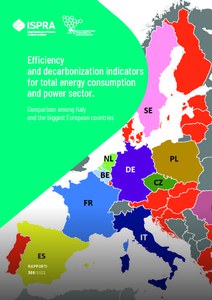Efficiency and decarbonization indicators for total energy consumption and power sector. Comparison among Italy and the biggest European countries
Efficiency and decarbonization indicators updated to 2020 have been analyzed in relation to energy consumption and greenhouse gas emissions. The 2020 is the benchmark year to verify the EU's climate and energy targets established with the Climate and Energy Package. Moreover, in 2020 the Covid-19 emergency has heavily affected the European countries’ economy and GHG emissions.
The indicators for Italy and the largest European countries have been compared. The role of driving factors for GHG emission trends has been analyzed, such as economic growth, fossil and renewable energy, transformation efficiency, and fossil fuel GHG emission factors. Transformation efficiency indicators and GHG emission factors for electricity and heat production have been estimated for Italy and largest European countries. The power sector performances of main European countries have been compared for fuel mixes, transformation efficiencies, and GHG emission factors.
Italy shows higher transformation efficiency and lower energy intensity than the largest European countries. The European carbon intensity is lower than the Italian one for the presence of a non-negligible share of nuclear energy in Europe. However, the Italian fossil fuels carbon intensity is lower than most European countries due to lower share of coal and higher share of natural gas than that observed for the European average. The decreasing final energy intensity and the increasing share of renewables have played a key role among the factors determining the European GHG emission reduction since 2005.
Publication available online
Download the publication(pdf - 17.2 mb)

